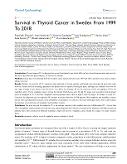Survival in Thyroid Cancer in Sweden From 1999 To 2018

Author
Koskinen, Anni
Sundquist, Kristina
Publication date
2024Published in
Clinical EpidemiologyVolume / Issue
16 (2 October 2024)ISBN / ISSN
ISSN: 1179-1349ISBN / ISSN
eISSN: 1179-1349Metadata
Show full item recordCollections
This publication has a published version with DOI 10.2147/CLEP.S467874
Abstract
INTRODUCTION: Thyroid cancer (TC) is diagnosed in several histological types which differ in their clinical characteristics and survival. We aim to describe how they influence TC survival in Sweden. METHODS: Cancer data were obtained from the Swedish cancer registry between years 1999 and 2018, and these were used to analyze relative survival. RESULTS: Relative survival for all TC improved when analyzed in 10-year periods, and female survival improved more than male survival. Female survival advantage appeared to be present also for specific histological types, although case numbers were low for rare types. Female 5-year relative survival for TC was 100% for follicular, 95.1% for oncocytic, 93.4% for papillary, 89.7% for medullary, and 6.1% for anaplastic cancer. Among the clinical TNM classes, only T4 and M1 stages were associated with decreased survival compared to T1-3 and M0. Anaplastic cancer presented most often at high T and M1 stages, in contrast to other TC. Curiously, the diagnostic age for anaplastic M1 patients was lower than that for M0 patients. Both anaplastic and medullary cancers did not show age-dependent increases in the probability of metastases, in contrast to the main histological types. This could indicate the presence of several types of anaplastic and medullary cancers. CONCLUSION: The poor survival for anaplastic TC is an extreme contrast to the excellent survival of differentiated TC. As less than 20% of anaplastic cancer patients survived one year, urgent diagnosis and initiation of treatment are important. Facilitated treatment pathways have been instituted in Denmark resulting in improved survival. Anaplastic cancer should be a target of a major research focus.
Keywords
anaplastic cancer, metastasis, prognosis, relative survival, trends
Permanent link
https://hdl.handle.net/20.500.14178/2726License
Full text of this result is licensed under: Creative Commons Uveďte původ-Neužívejte dílo komerčně 3.0 Unported







